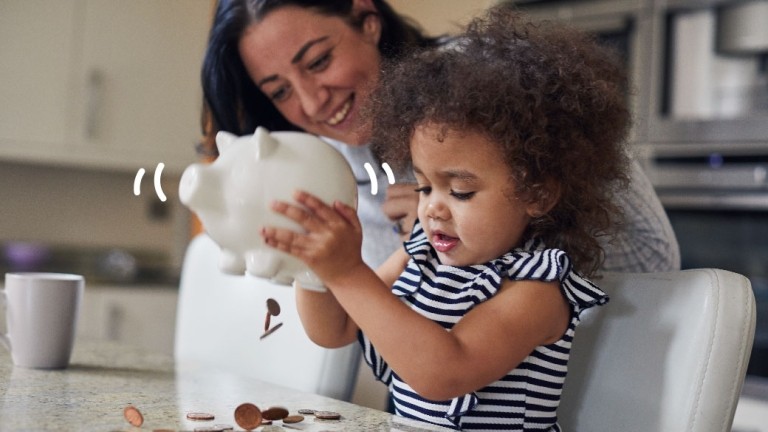Teach good money habits to kids with the spend, save, share plan

Want to prepare your kids for a lifetime of financial wellness? It’s important to help them develop a healthy relationship to money before their habits become fixed — and that happens sooner than you might think.
Kids can grasp basic money concepts as young as age three. Research has shown that by age seven, they’ve already developed many of the money habits they’ll carry into adulthood, such as planning, budgeting, delayed gratification and returning borrowed items. They’ll continue developing other relevant habits, such as self-responsibility and the ability to act even when they’re not excited about the task, until age nine, says personal finance teacher Rob Phelan.
Teaching your kids how to save and budget their money at an early age helps them develop good money habits that will set them up for long-term financial wellness. If you’re not sure how to go about it, many financial experts recommend starting with the spend, save, share plan. It’s a wonderfully simple formula that teaches kids the fundamentals of finance, including:
- The value of money.
- The importance of saving for the future.
- The joy of sharing.
- The basics of budgeting.
How it works
The spend, save, share plan is essentially a simplified budgeting strategy. Each time your child receives money, have them divide their funds into three buckets: One for spending, one for saving and one for giving away to others. You can decide what percentage of each dollar earned goes into each bucket.
We recommend a plan that looks something like this:
Spend — 50 percent
As adults, we don’t have the luxury of spending all our money on things we want. If kids get used to spending every penny of their earnings, there’s a good chance they’ll carry this habit into adulthood. The spend, save, share plan helps get them acclimated to the idea of spending only a portion of each dollar on things they want.
Save — 30 percent
Saving money teaches powerful lessons about delayed gratification and planning for the future. You can even make it exciting by encouraging your child to set a goal and track their progress each time they deposit money into their savings account. As they gradually achieve their goal, they’ll learn that some things are worth waiting and saving up for.
Share — 20 percent
Kids naturally love helping others. They instinctively understand that giving and sharing makes us happier — and financial wellness is all about using your money in a way that contributes to your long-term happiness. When your child’s compassion gets triggered by someone in need, their share bucket empowers them to lend a hand and do some good in the world.
Why the spend, save, share plan is so effective
What makes this simple saving strategy so powerful?
For one thing, it mirrors a common budgeting technique we often recommend to adults, known as the 50-30-20 rule. This easy system also involves dividing your monthly income into three buckets: 50 percent for needs, 30 percent for wants, and 20 percent for savings and debt repayment. It’s a flexible budget that can adapt as your income changes while ensuring your necessary expenses are covered and your savings stay on track.
Starting kids out with the spend, save, share plan helps them practice basic budgeting skills and instills the habit of saving part of their income. As they get older and start taking on more financial responsibility, they’ll already have the skills to handle a percentage-based budgeting system, which will help them to live within their means no matter how much money they make.
The spend, save, share plan is a simple and powerful way to help your kids develop good money habits. By teaching them to divide their earnings and save a portion of every dollar, you can lay the foundation for a lifetime of financial wellness.


